Christmas in Western Bohemia
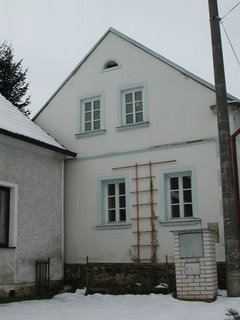 As I noted earlier, Štěpanka invited Jesse and me to spend Christmas with her and Michael in their village cottage.
As I noted earlier, Štěpanka invited Jesse and me to spend Christmas with her and Michael in their village cottage.It is important to explain, before I go any further, that the Czech relationship between city and country is somewhat different than the American. Not wholly different, but different all the same. As in the United States, many urban Czechs were brought up in small towns or rural areas; unlike in the United States, most of them make regular visits (often weekly or monthly) to the relatives back home. Conversely, many Czechs born in the larger cities have little cottages to which they retire nearly every weekend. This means that from about 2:00 each Friday until about noon on Saturday the outward-bound buses are packed with Czechs heading out of the cities. They then return sometime after noon on Sunday.
Štěpanka not only has a cottage in a village, but lives there year-round and commutes in to Plzeň and Prague to teach. Her son Michael used to attend the local schools but now spends the weekdays in Prague with his grandmother so that he can go to a more academically demanding school there. Thus, on Fridays he joins the outbound migration.
As the Friday buses were expected to be even more packed than usual, Štěpanka advised that Jesse and I pay a bit more and take the train to Plzeň, from whence we could catch a local bus. This worked splendidly, as the train was only moderately full.
 The plan was that we would look around Plzeň a bit while waiting for our bus, as Jesse had never been there and I had not seen anything but the bus station since about 1990, but this didn’t really work out as I had an overnight bag filled with presents and root vegetables, and furthermore, we had stayed up too late the night before to get a very early start. (Something about it getting dark around 4:30 makes it much easier for me to stay up until midnight or 3am than is normally my custom.) However, we thought the main square in Plzeň was quite attractive, and its Vánoční trh looked more varied than those in Prague. I remembered that there used to be an interesting museum of local folk culture on the square, but we didn’t find it, so we devoted our time to eating and coffee-drinking instead. The trip to the village itself was longish but uneventful. (In daylight, and if the bus windows are clean, the scenery is pretty.)
The plan was that we would look around Plzeň a bit while waiting for our bus, as Jesse had never been there and I had not seen anything but the bus station since about 1990, but this didn’t really work out as I had an overnight bag filled with presents and root vegetables, and furthermore, we had stayed up too late the night before to get a very early start. (Something about it getting dark around 4:30 makes it much easier for me to stay up until midnight or 3am than is normally my custom.) However, we thought the main square in Plzeň was quite attractive, and its Vánoční trh looked more varied than those in Prague. I remembered that there used to be an interesting museum of local folk culture on the square, but we didn’t find it, so we devoted our time to eating and coffee-drinking instead. The trip to the village itself was longish but uneventful. (In daylight, and if the bus windows are clean, the scenery is pretty.)Czech Christmas customs are similar to North American, but not precisely the same. Of course, as in the United States, each family has slightly different traditions. Štěpanka, for instance, is not exactly religious but does like to attend (non-midnight) mass at the village church (a handsome baroque structure designed by that energetic architect Dienzenhofer).
 During most of the year, there are about four people in attendance there, but we noticed that the holiday upped the count to at least twenty, about half of whom were children under the age of seven who were going to sing carols for us after the service. The mass was said in Czech, and the priest enunciated very nicely, so I was disappointed that echoes and rustling noises made it harder for me to follow what he said; I tend to do very well listening to things like lectures and mass because the subject matter is clearly defined and I can put my full attention onto listening rather than half on listening and half on worrying what to say in response. From time to time I was able to find where we were in the printed booklet, but only from time to time, as the booklet only seemed to cover parts of the ceremony.
During most of the year, there are about four people in attendance there, but we noticed that the holiday upped the count to at least twenty, about half of whom were children under the age of seven who were going to sing carols for us after the service. The mass was said in Czech, and the priest enunciated very nicely, so I was disappointed that echoes and rustling noises made it harder for me to follow what he said; I tend to do very well listening to things like lectures and mass because the subject matter is clearly defined and I can put my full attention onto listening rather than half on listening and half on worrying what to say in response. From time to time I was able to find where we were in the printed booklet, but only from time to time, as the booklet only seemed to cover parts of the ceremony.The standard Christmas Eve dish here is carp, which (if the family is really traditional) is bought live shortly before Christmas, kept in the bathtub, and then slaughtered by whoever has the nerve. (I meant to photograph the carp tubs, but didn’t, so you can see them on Julia’s blog.) These days, many families are not wild about keeping a live carp in the tub and having to slaughter it. Věra told me that in recent years, a lot of people bought live carp to entertain the children but then released the fish into the Vltava rather than killing it. Unfortunately, it turned out that the carp couldn’t tolerate so many changes of water in such a short period (they normally live not in the Vltava but in placid rybníky), so the Vltava was filled with dead carp, hardly the ecological solution these families had in mind. It sounds as though many people have now switched to having either chicken or to buying their carp pre-killed, or having someone come over and kill it. Štěpanka does not kill her own carp, and it was sliced up in the refrigerator by the time we arrived. Once it was taken out, it was guarded zealously by Vegetka, who clearly expected to get some (she did, eventually).
Our Christmas Eve dinner, then, consisted of fried carp (very good) and potato salad. Potato salad is a traditional side dish, but some families have other dishes instead of potato salad (I think with peas, but I’ve forgotten what exactly). After dinner, we opened presents and listened to some Christmas music. Some of the traditional Christmas music here is the same as what one would hear in the US, but most of it is different; I would say that the shared music seems to be primarily that of German origin. Also, instead of Händel’s Messiah, the standard classical work performed is Jakub Jan Ryba’s Christmas Mass.
On Christmas Day, Jesse and I were in charge of the food apart from that Štěpanka had acquired a goose. Štěpanka had cooked a goose once before and none of the rest of us had any experience at all in cooking large birds, so the goose was her part. It is a pretty traditional main dish for Christmas Day, but obviously not one eaten every year in all households.
My own family does not have any required holiday dishes, but we do often have cranberry sauce and baked sweet potatoes at Thanksgiving and/or Christmas, so when I ran across a bag of Ocean Spray cranberries and a bin of yams at the grocery store, I had not hesitated to nab them. The checkout clerk examined the yams with curiosity and inquired if they were potatoes, a bit sweet. I said that they were. Another employee, an African Czech, happened to be near, and so he told us “Jsou naše brambory” (they’re our potatoes). I agreed and said they are delicious. I was tempted to ask just where he came from, but was afraid that if I did, it would turn out he had been born in Prague. Besides, the line behind me was too long to engage in an extended conversation about yams or Africa. (Nor do I know why yams, which are African, and sweet potatoes, which are South American, cook up exactly the same.)
Anyhow, I had volunteered that Jesse and I, being fond of cooking, could make some things like mashed potatoes, roasted vegetables, and perhaps a pie. Once the yams appeared on the scene, the mashed potatoes were given up, but we still had one of the pumpkins Jesse had been given back in October, and it was still good, so we had brought it and various other foodstuffs.
I must note that Czech ovens are not typically as large as American ovens. This is generally not a problem; one only really notices the difference when trying to bake large or multiple items. Štěpanka’s oven, moreover, is smaller than many. This made for a slight logistical problem in that the goose required the entire oven for several hours while the yams needed perhaps half an hour, the roasted vegetables needed in theory at least twenty minutes but in practice more like fifty, and the pie also needed to be baked (both the pumpkin slices and the filled pie). We handled this by starting with the pumpkin slices, then giving the yams about twenty minutes, then doing the goose, and then popping in the yams and vegetables simultaneously while the goose was being dismembered.
In theory, this strategy was not unsound. Yams and roasted vegetables are pretty forgiving of being popped in and out of ovens repeatedly. On the other hand, yams do take time to heat up, and roasted vegetables do take awhile to roast. They did turn out all right in the end, and the cranberries also turned out just fine.
The goose and the pie, however, proved a bit problematic. We don’t know why, as they both had tender attention from the cooks. Unfortunately the goose, while flavorful, proved to have a texture somewhat akin to heavy-duty rubber. There also did not seem to be much meat on it, which was mystifying. It was very difficult to find the meat and remove it from the bones. Vegetka will be feasting for days to come.
The pie crust was supposed to be browned in advance of being filled, so it too went into the oven after the goose came out. For reasons unknown to us (and even to my mother, an expert who was queried after the fact), the pie crust refused to brown, but sank into an oily mass in the bottom of the pan. (The only cause I can think of is that Michael put a curse on it by announcing early on that it would turn into a nuclear reactor and glow green.) Jesse was disconsolate that his pie crust should behave so, and expressed an intention to throw it out. Štěpanka and I were less pessimistic, and thought it could be salvaged, so I massaged it back into a pie-crust-like shape, we poured in the filling, and sent it back into the oven.
The sides of the pie crust eventually browned, and on the whole the filling cooked up tolerably, but the bottom of the pie was not quite what it should have been. The females in the group ate it all contentedly, but the males were pickier and ate only the tops of their pieces.
No matter, there was plenty of food, most of it was enjoyed, and wine, eggnog, and cookies were also consumed.
Other Christmas entertainments included roaming around the village and its environs (Michael was very skillful at leading us through shrubbery and up and down steep snowy gorges that required special climbing techniques), snowball fights, soccer played with chunks of ice (feet only, no other body parts), and a special showing of The Big Sleep, one of my presents to Michael (both it and The Invisible Man went over very well, to my relief).
And so a good time was had by all, even if not in quite the sentimental manner suggested by most holiday propaganda.
 Michael and Jesse in front of the village information center. It is new and actually very nicely done, although we were startled to hear it say that the former German inhabitants had "moved on" after the war, a euphemism that suggested they were some sort of nomads rather than that they had been forcibly ejected.
Michael and Jesse in front of the village information center. It is new and actually very nicely done, although we were startled to hear it say that the former German inhabitants had "moved on" after the war, a euphemism that suggested they were some sort of nomads rather than that they had been forcibly ejected. The town hall.
The town hall.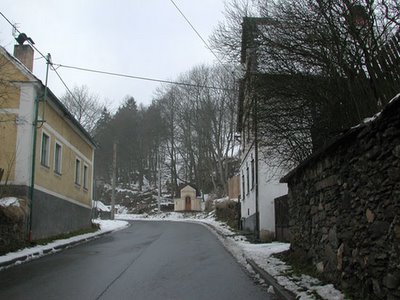 A view up the street to the local shrine.
A view up the street to the local shrine.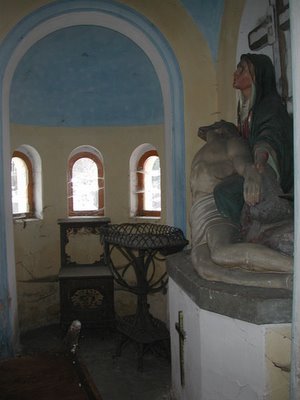 The inside of the shrine, courtesy of a broken window.
The inside of the shrine, courtesy of a broken window.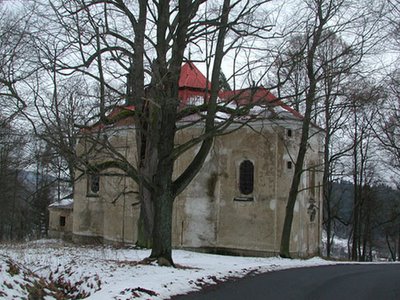 An abandoned church up the hill (not as large as the Dienzenhofer church, which I failed to get a good photo of). The abandoned church also appears to be baroque.
An abandoned church up the hill (not as large as the Dienzenhofer church, which I failed to get a good photo of). The abandoned church also appears to be baroque.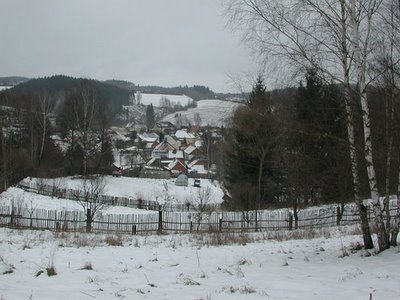 A view down the hill taken between snowballs.
A view down the hill taken between snowballs.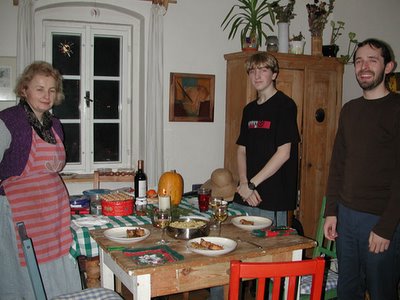 Christmas Eve with carp.
Christmas Eve with carp.Note: for more details about the holiday excitements (I forgot to mention the arsonist story and other matters), and for a link to an amusing insight into Czech gnomes, see Jesse's account of the weekend.
Labels: Czech, food, friends, holidays, music, travel, winter

0 Comments:
Post a Comment
<< Home